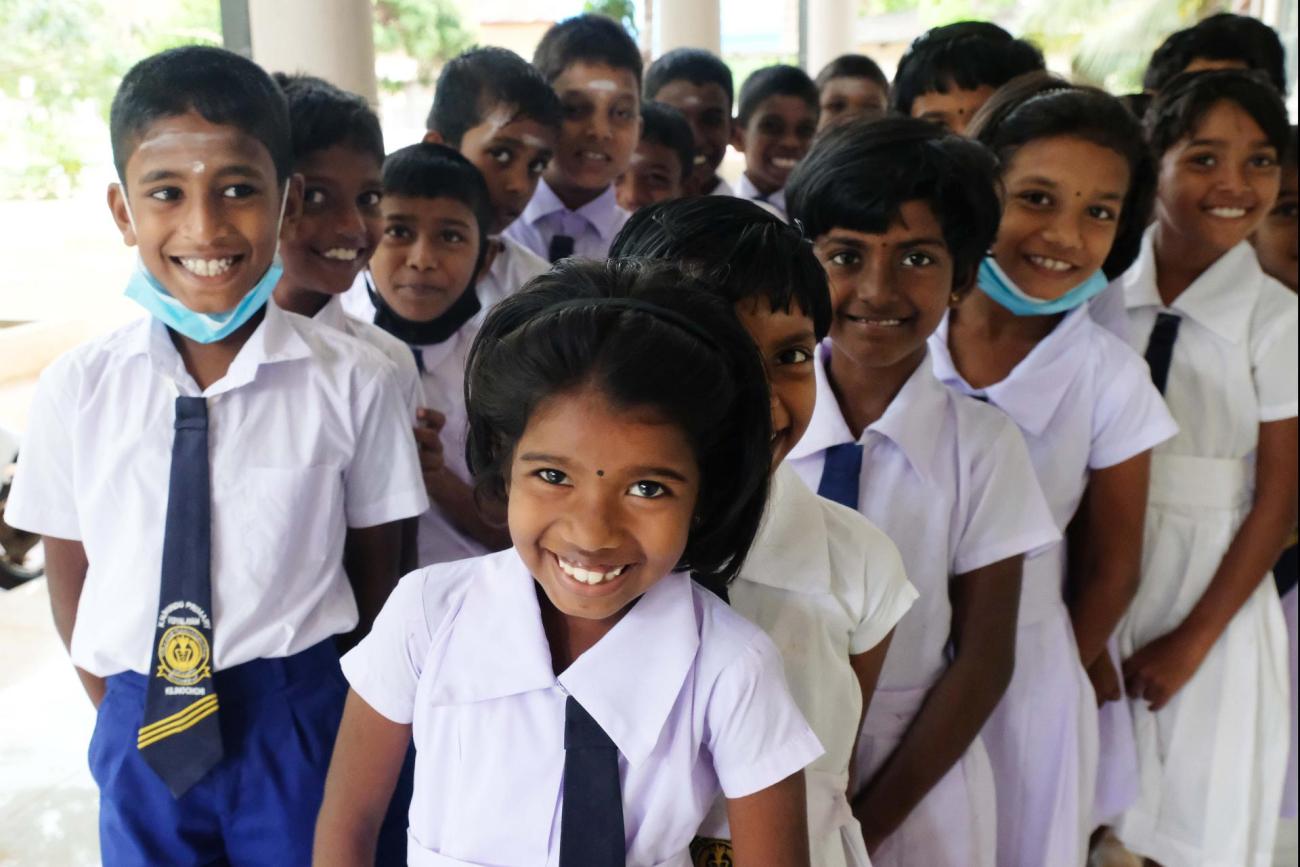Learning Opportunities to Smile About

Transforming rural schools in Sri Lanka to provide the best learning conditions for children.
The Hindu Primary School, Kilinochchi in the Northern Province of Sri Lanka is a small establishment, but, sturdy, bright and clean. There’s a positive energy and enthusiasm amongst the nearly 400 girls and boys. Lively eagerness and bright smiles compliment the school atmosphere.
However, the atmosphere of the school has not always been so positive. “The classrooms were dank and dark and bats used to nest in them,” recalls Ms Viswanathan (45), a mother of twin daughters presently studying at the school, and an older daughter who previously studied here. “Our children had to study amidst bat droppings, in darkness.”
In 2018 the parents started seeing a change in the school when 13 underperforming schools in the Kilinochchi district, including the Hindu Primary school, came under the Educational Environment Improvement Project conducted in the district. Under the project, school facilities as well as teaching and learning methods were developed to improve education conditions for the children.
“The school suddenly became an exciting place for our children,” Ms Viswanathan continues. The buildings were refurbished to be airy, bright and colourful. An activity room with advanced learning implements, reading room with new books, and the new playground, enchants the children. The children are eager to go to school”
“My children’s reading has definitely improved; teachers read stories to them and encourage them to read further in the reading room. As a result, they have taken up reading as a habit, she adds”
“As parents we appreciate the progress the school has made and are in regular touch with the staff to give back to the school in any way we can. We get together regularly to clean the school and take part in related school activities as needed.”
“More than anything, learning is made easier for the students through new techniques the teachers started using. The teachers and the students were alive! Classrooms were interactive and students felt that the teachers were approachable and kinder.”
Building capacity of teachers and principals of schools is a key component of the project. Led by UNICEF with the financial support from the Korea International Cooperation Agency (KOICA), the project aims to promote better learning outcomes for children through enhanced conditions. This includes diverting from the traditional linear teaching methods and diversifying formal schooling methods to provide learning opportunities for all children regardless of needs, capacities and paces.
Ms Suthahar (49), a teacher at the school, concurs with Ms Viswanathan’s observation on the standards of teaching. “In my 20-plus years of teaching, I have never felt so engaged as a teacher. With the skills I gained through the training, I can now make a bigger impact in the classroom. And I can experience the enhanced learning of my students”
“From the way we teach multiplication tables in mathematics to remembering new words and phrases in English, to improving their overall reading and writing skills, everything is much simpler yet more innovative and effective. I find it a marvel and am so thrilled to be able to use these methods to identify children’s unique talents and promote them.”
Ms Suthahar who is confident in applying the new teaching methods is keen to help out other teachers. “Teachers from schools not fortunate enough to come under this project are envious of us. At interschool teachers’ meetings, they often come up to me and ask me to impart some of my newly learned teaching methods to them. When they implement it and see dramatic results, they call me later, thrilled to report how well the new methods are working on their students.”
Enhanced learning conditions at the Hindu Primary is also reflected through improved student performance at public examinations. “Since the introduction of new teaching methods 4 years ago, we are seeing solid performance improvement,” claims Mr. Palan Kaneshamoorthy (59), the Principal, Hindu Primary School. “Our ratings at the Grade 5 scholarship exam are steadily increasing; two years ago, 18% of students passed their scholarship exams. Last year, it rose to 20%. Likewise, two years ago 87% scored above 70/200 in the scholarship exam, last year, that rose to 90%.”
Having been the Principal of the Hindu Primary School for nine years, Mr Kaneshamoorthy clearly sees a difference in the attitude of the children.
“It is evident that the students are keen to study and learn in the classrooms and are more curious and open to exploring learning in the reading and activity rooms. Instilling reading habits in children was one of our biggest challenges and the reading room has done the job!”
“Our students come from diverse backgrounds, with various levels of vulnerabilities. Those from care homes and disrupted homes fall behind their studies as they don’t get the expected support outside of school. With the facilities and the trainings we have received, we are now able to guide them to utilize the activity and reading rooms to progress with their learnings and where possible inculcate self-learning habits.”
“The project interventions have definitely improved the school atmosphere. The children and staff are happy, and this further contributes towards teaching and learning. The playground provides adequate physical activity for the children, which they love to use; right after early morning assembly, they are given some time to play; it’s such a thrill for them to swing, slide and climb all over the playground. So, when they start their classroom learning exercises they are in a very good mood. That too helps them with their learning,” he affirms the positive results gained through the project.

